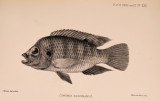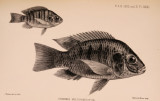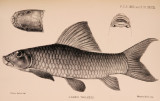| OCR Text |
Show MR. H. R. HOGG OX AUSTRALASIAN SPIDERS. 455 Genus Typostola E. Sim. Typostola E. Sim. Hist. Nat. des Ar. vol. ii. p. 44. Type species, T. barbatct (L. Koch). ^ . Simon removes this species from Isopeda and makes it the 3 pe o a ne\v genus on the strength of the somewhat larger size of le rear me ran eyes compared with the laterals, and the curious aeveiopment ot a mass of very long and stout plumose bristles on the rnner srde of the mandibles and the outer side of the maxilla?. in the specimens in the British Museum (two females and a ma e) le former point is not by any means clearly shown, but m the male palp the spiral support and flagellum are only partially developed, being in fact in the intermediate stage; it is ere ore, I think, a quite good genus. The outer mandibular teeth are also five, instead of the four in Isopeda. The comparative nearness of the rear middle eyes in some cases makes the eye-square longer than broad. The female specimens in the British Museum differ from one another in minor points, and considerably from the male. All three, so far as_ can be judged, are different from L. Koch's T. barbata, but it must be remembered that they are all single specimens. The Rev. 0 . P. Cambridge has a fine female agreeing wrth the largest T. magnifica, which he was good enough to allow me to inspect. The following synopsis shows the chief points of difference. I am not quite satisfied as to how far T. major really differs from T. barbata L. Koch, but his drawing of the epigyne, if correct and from a fully adult specimen, should be conclusive. A. Lip and maxillae yellow-brown. Rear side-eyes longer than the front laterals and clearly much larger than the rear middle, at least in male. Cephalothorax shorter than tibia iii. ............................................................................ broomi, nov. sp. B. Lip and maxillae dark or nearly black-brown. Front and rear laterals of equal diameter. a1. Lip and maxillae scarcely any lighter at extremities. Cephalothorax clearly longer than broad, as long as tibia iv. and in front as wide as the mandibles are long ..................................................................................... magnified, nov. sp. bx. Lip and maxillae much lighter at extremities than in the above. Cephalothorax as broad as long, clearly longer than tibia iv., and wider in front than mandibles are long. a2. The points of the chitinous oval of the epigyne widely apart at base. Rear middle eyes more than one and a half times their diameter apart................ major, nov. sp. I 2. Chitinous oval of epigyne closed at base (sec. Koch). Rear middle eyes only slightly farther apart than their diameter ................................................................ barbata L. Koch. T y p o s t o l a b r o o m i , nov. sp. (Text-fig. 100, p. 456.) Cephalothorax, lip, and maxilla? orange-brown; mandibles the same but darker; beard pale orange; sternum and coxae yellow with pale yellow hair; legs somewhat darker ; scopuke dark grey. Abdomen dingy orange with yellowish-grey hair, both lighter on underside, no signs of any pattern |
































































































































































































































































































































